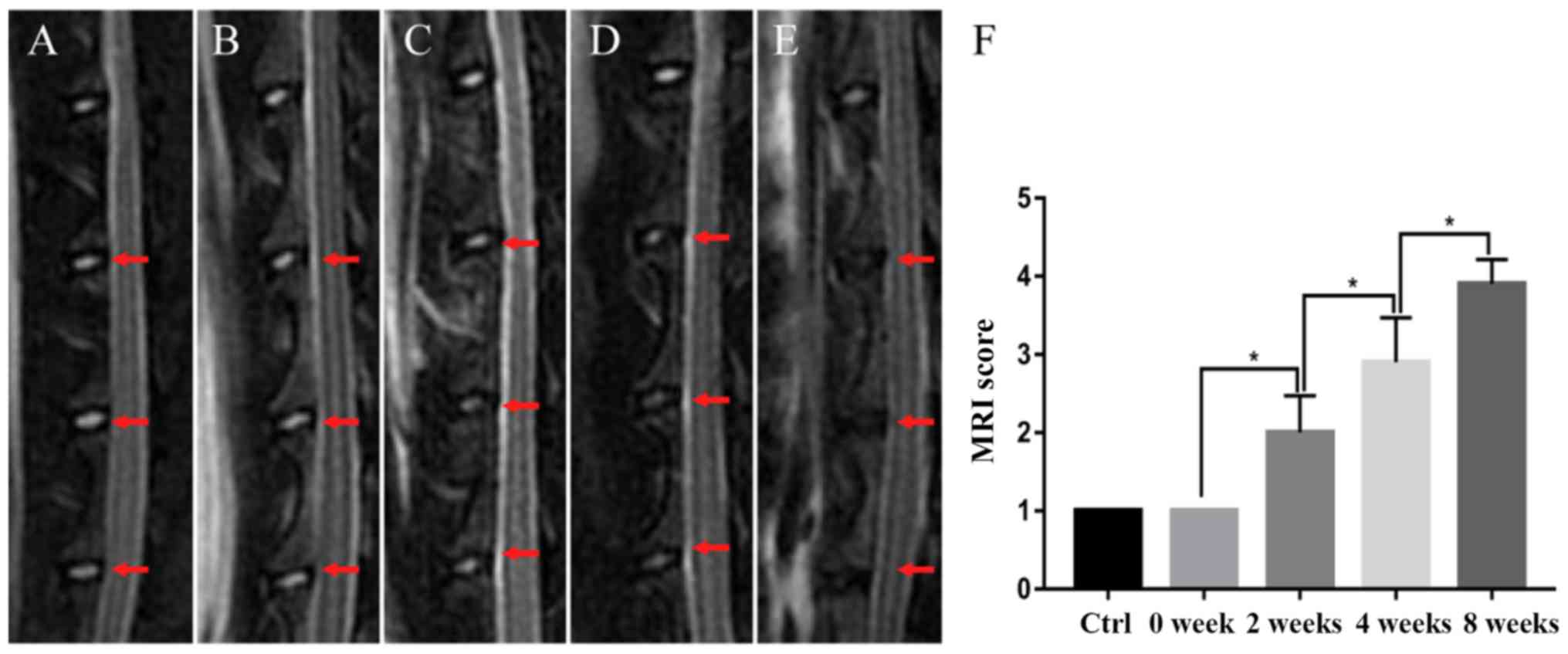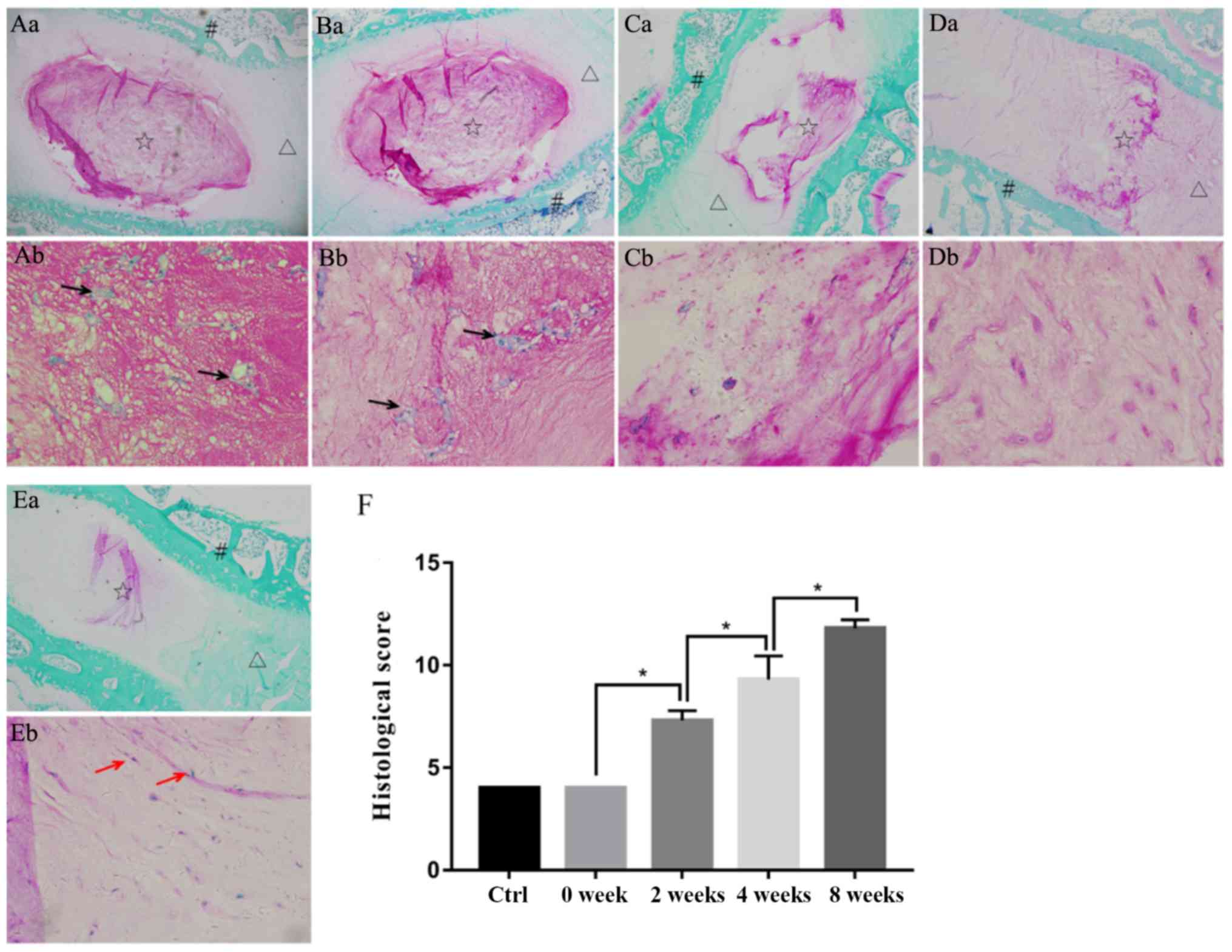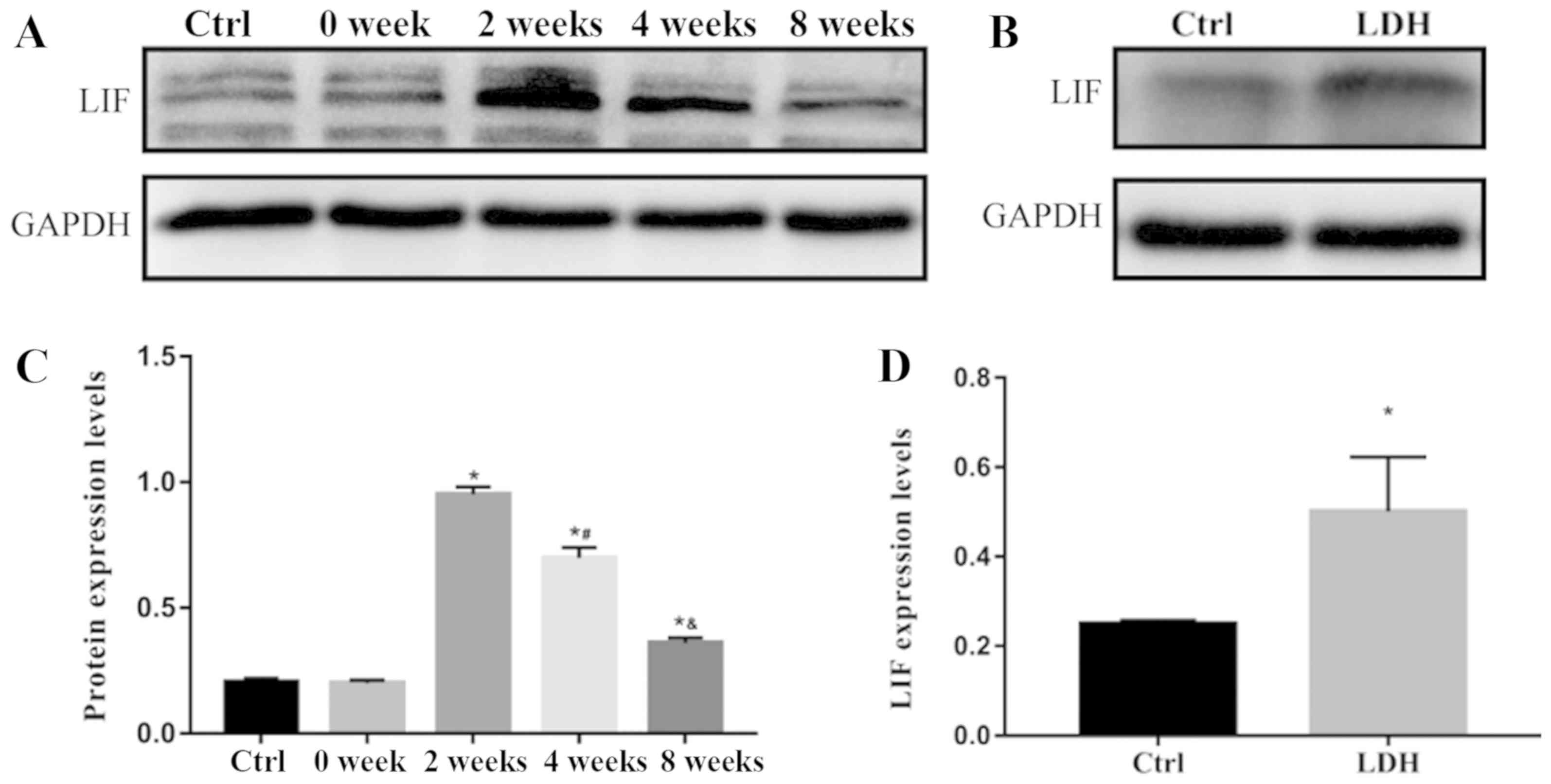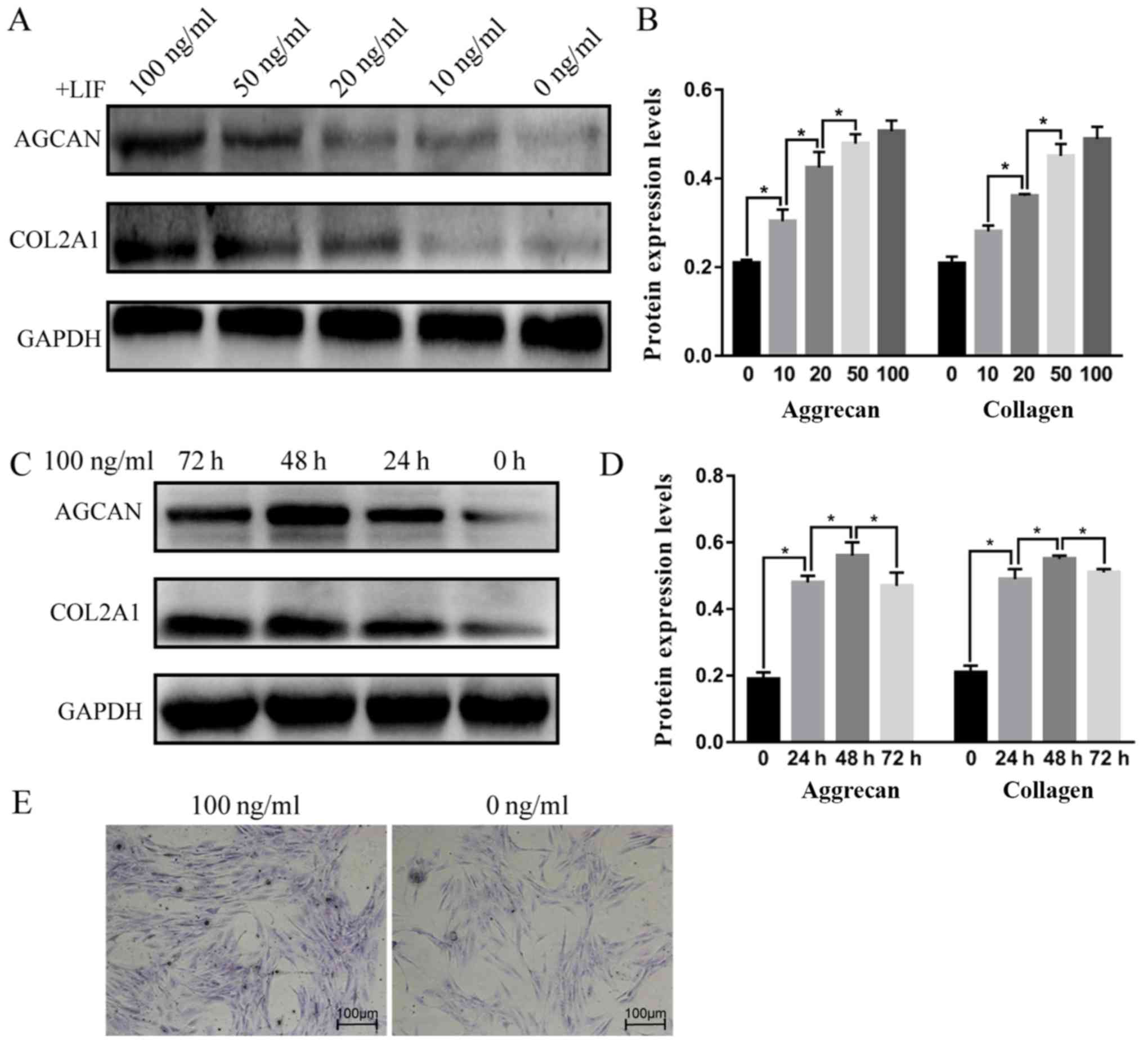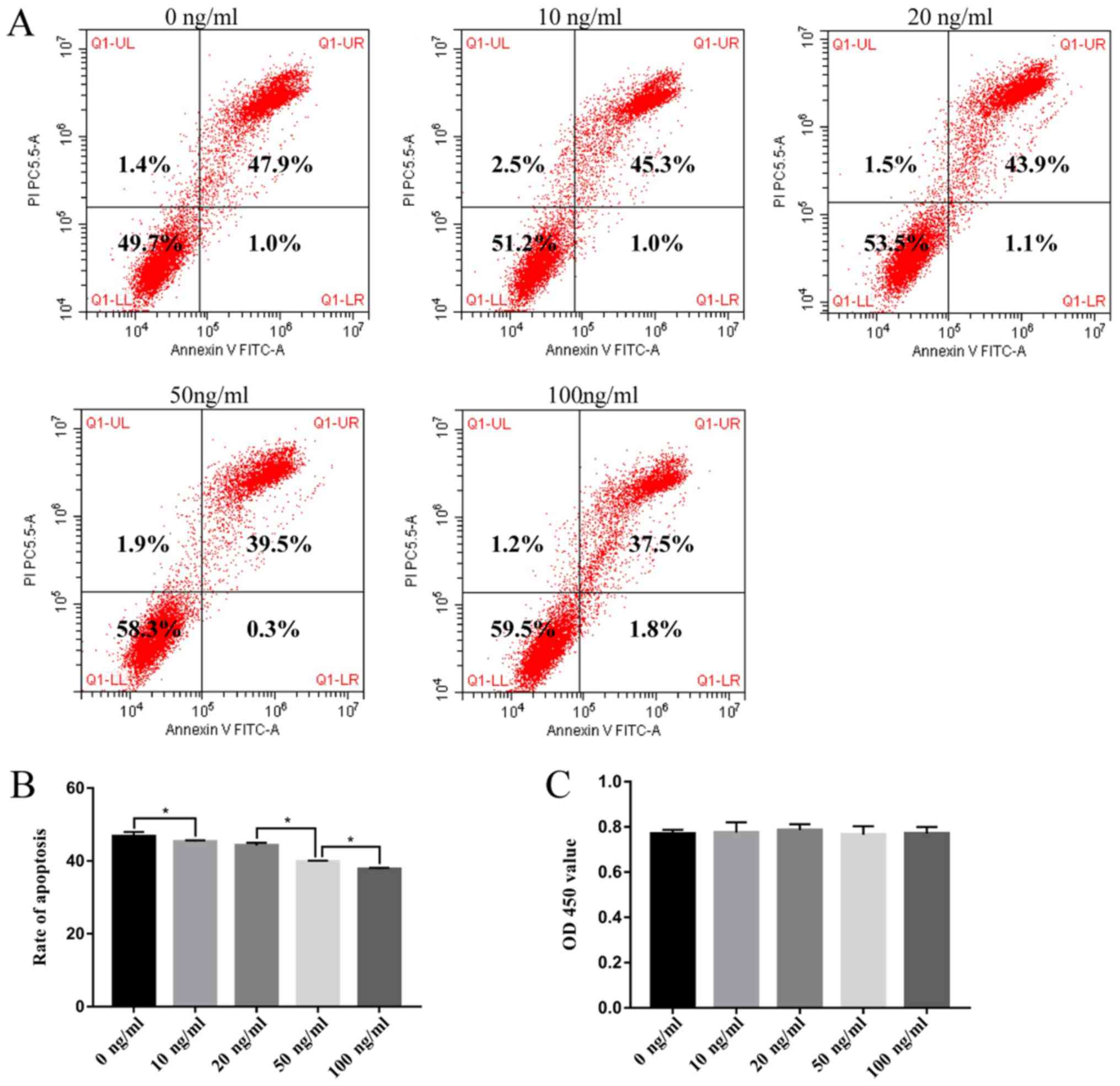Expression and effects of leukemia inhibitory factor on nucleus pulposus degeneration
- Authors:
- Published online on: January 17, 2019 https://doi.org/10.3892/mmr.2019.9874
- Pages: 2377-2385
Abstract
Introduction
Lower back pain caused by degenerative spinal conditions is a serious public health problem. It is estimated that between 2.8 and 5% of visits to health-care professionals in the United States are due to this problem, and considering direct and indirect costs, the overall cost is >$100 billion per year (1). It has been suggested that intervertebral disc degeneration (IDD) is a major causative factor in the development of spinal degenerative diseases (2); however, the specific pathogenesis of IDD remains unclear. Extracellular matrix synthesis and catabolic imbalance are believed to be direct causes of IDD (3). It is well known that inflammatory cytokines, including interleukin IL-1, tumor necrosis factor-α and IL-6, serve an important role in cellular apoptosis and extracellular matrix metabolism in the process of IDD (4,5).
Leukemia inhibitory factor (LIF) was first reported in a study regarding myeloid leukemia M1 cells (6). It is a 180-amino acid glycoprotein that belongs to the IL-6 sub-family, which is comprised of seven members, including IL-6, IL-11, IL-27, oncostatin M (OSM), ciliary neurotrophic factor, cardiotrophin-1 and cardiotrophin-like cytokine/cytokine-like factor (7). The aforementioned cytokines share the same receptors, including LIF receptor β (LIFRβ) and glycoprotein 130 (gp130) (8). LIF is a multifunctional cytokine that exerts various activities on numerous systems, including bone remodeling, and the nervous, muscular, endocrine and reproductive systems (9). Previous studies have reported that LIF is involved in several osteoarticular pathological conditions (10–12). Lotz et al demonstrated that LIF promotes cartilage catabolism and contributes to the pathogenesis of arthritis (13). Although chondrocytes and nucleus pulposus cells have been reported to share many cellular phenotypes (14), whether LIF is positively expressed in the nucleus pulposus of intervertebral discs, and its roles in IDD, have yet to be evaluated.
The present study aimed to evaluate the expression of LIF in the degenerative nucleus pulposus of an animal model and in patients with lumbar disc herniation. Furthermore, the effects of LIF on extracellular matrix synthesis, proliferation and apoptosis were detected in degenerative nucleus pulposus cells (DNPCs).
Materials and methods
Materials
A total of 50 adult male New Zealand rabbits (weight, 2.5±0.2 kg), were purchased from the Experimental Animal Center of Chongqing Medical University (Chongqing, China). Animals were maintained in a 26°C room with 40–70% humidity and a 12-h light/dark cycle, and were allowed free access to food and water. In addition, degenerative disc samples were obtained from six patients undergoing lumbar disc herniation surgery (age, 27–68 years; mean age, 48.6 years; three men and three women; Pfirrmann degeneration grading, III–IV). Nucleus pulposus tissues were also obtained from a control group (age, 17–49 years; mean age, 37.1 years, three men and two women), which consisted of young trauma patients (three cases) and adolescent patients with scoliosis (two cases). All animal and patient procedures were approved by the Ethics Committee of the First Affiliated Hospital of Chongqing Medical University (Chongqing, China). Written informed consent was obtained from adult patients and the parents of adolescent patients permitting the use of their samples and the publication of any associated data.
Reagents
Pentobarbital sodium was purchased from Merck KGaA (Darmstadt, Germany). Safranin O-Fast Green staining reagent was obtained from Beijing Leagene Biotech Co., Ltd. (Beijing, China). Dulbecco's modified Eagle's medium (DMEM)/F12 and fetal bovine serum were obtained from HyClone; GE Healthcare Life Sciences (Logan, UT, USA). Recombinant Human LIF Protein was purchased from Novus Biologicals, LLC (Littleton, CO, USA). Collagenase type II was obtained from Sigma-Aldrich; Merck KGaA. Collagen type II α1 (COL2α1) and LIF primary antibodies were from BIOSS (Beijing, China; bs-1068R and bs-1058R), and aggrecan primary antibody was from Abcam (Cambridge, MA, USA; ab3778). Cell Counting Kit-8 (CCK-8) was purchased from Beyotime Institute of Biotechnology (Haimen, China) and the Annexin V-phycoerythrin (PE)/propidium iodide (PI) apoptosis detection kit was obtained from BD Biosciences (Franklin Lakes, NJ, USA).
Animal grouping and model establishment
A total of 50 New Zealand white rabbits were randomly divided into the following 5 groups, with 10 rabbits in each group: The control group, and the 0, 2, 4 and 8 week groups according to modeling time. According to the method introduced by Masuda et al (15), 3% pentobarbital sodium (30 mg/kg) was injected into the marginal veins of each rabbit, intervertebral discs between L4-5, L5-6 and L6-7 were exposed via the posterior lateral approach and the annulus fibrosus was punctured using a 18G needle (5 mm depth for 5 sec). The incision was then closed in layers.
Imaging evaluation
After modeling at 0, 2, 4 and 8 weeks, sagittal T2-weighted magnetic resonance imaging (MRI) scans of the lumbar spine were performed under the following parameter settings: Repeat time, 2,500 msec; echo time, 85 msec; scanning layer, 11; layer thickness, 2 mm; matrix, 196×196; bandwidth, 31.25; field of view, 18×18. The intervertebral discs were evaluated according to the method introduced by Masudaet al (15). Images and scoring of the discs were assessed by two experienced, independent radiologists.
Histological assessment
Rabbits were sacrificed on the day that MRI examinations were conducted, after which, discs were removed and fixed in 4% paraformaldehyde for 24 h at room temperature. They were then decalcified in EDTA solution for 4–5 weeks (decalcifying solution was replaced every 3–4 days). Disc tissues were embedded in paraffin, sliced into 5 µm sections on the median sagittal, dewaxed in water and then stained with Safranin O-Fast Green, according to the manufacturer's protocol. Pathological assessment of degeneration was performed according to the Masuda criteria under a confocal microscope (Olympus Corporation, Tokyo, Japan) (15).
Measurement of LIF expression in intervertebral disc nucleus pulposus
Total proteins were extracted from nucleus pulposus samples harvested from rabbit and human discs by grinding in liquid nitrogen (PROTTOT-1KT, Sigma-Aldrich; Merck KGaA). Protein concentrations were then measured using the bicinchoninic acid (BCA) method and the protein expression levels of LIF were detected in each group by western blot analysis. Briefly, 50 µg of extracted proteins were separated by 10% SDS–PAGE, then were electro-blotted onto PVDF membranes (EMD Millipore, Billerica, MA, USA). The membranes were blocked using 5% blocking buffer (P0252; Beyotime Institute of Biotechnology) at room temperature for 1 h. After incubation with rabbit anti-LIF antibody (1:1,000; SAB2102317; Sigma-Aldrich; Merck KGaA), membranes were washed 3 times with TBST (P0023C; Beyotime Institute of Biotechnology) for 10 min and followed by incubation with a secondary antibody (1:1,000; Sigma-Aldrich; Merck KGaA) for 2 h at room temperature, and were then washed 3 times again with TBST. Relative levels of immunoreactivity were quantified using the Kodak In-vivo Imaging System (Kodak, Rochester, NY, USA). Rabbit anti-GADPH (1:2,000; SAB2108668; Sigma-Aldrich; Merck KGaA) was used as an internal control for the concentration of proteins loaded. Images were analyzed using Image J version 2× (National Institutes of Health, Bethesda, MD, USA).
Culture of human DNPCs
Human nucleus pulposus cells were isolated from the obtained degenerative discs of patients as described previously (16). Blood in nucleus pulposus samples was washed away using PBS supplemented with penicillin (800,000 U/l) and streptomycin (1,000,000 U/l). The samples were cut into pieces using ophthalmic scissors, and were then digested using 0.25% trypsin and 0.2% type II collagenase. After sieving through a 200-mesh cell sieve, the cells were centrifuged (300 × g, 4°C, 5 min) and suspended in a culture flask and were cultured in DMEM/F12 medium containing 20% fetal bovine serum at 37°C in an incubator containing 5% CO2.
Detection of aggrecan and COL2α1 protein
Passage (P)2-P3 cells were seeded into 10-cm culture dishes and treated with recombinant human LIF protein (rhLIF) at 0, 10, 20, 50 or 100 ng/ml for 24 h at room temperature, or were treated with 100 ng/ml rhLIF for 0, 24, 48 or 72 h, as described previously (17). Subsequently, cells from each group were collected to extract total protein. After protein concentration was measured using the BCA method, the protein expression levels of aggrecan and COL2α1 were detected by western blot analysis.
P2 cells were also seeded onto glass slides and treated with 0 or 100 ng/ml rhLIF for 48 h. The slides were collected, rinsed with PBS, fixed with 40 g/l paraformaldehyde for 30 min at room temperature, and rinsed with PBS three times (5 min/wash). Subsequently, the cells were stained with 1 g/l toluidine blue stain for 10 min, washed with double distilled water for 1 min, and then placed under an inverted phase contrast microscope to detect proteoglycan staining (18).
Cell proliferation assay
P2 cells were treated with various concentrations of rhLIF and then incubated with serum-free medium for 24 h at room temperature. Cell proliferation was measured using the CCK-8 kit, according to the manufacturer's protocol. Cells were incubated with CCK-8 solution for 4 h and cell proliferation rate was assessed by measuring absorbance at 450 nm.
Apoptosis analysis
The apoptotic rate was detected by flow cytometry using the Annexin V-PE/PI apoptosis detection kit. P2 cells were treated with various concentrations of rhLIF and then incubated with serum-free medium for 24 h at room temperature. Cells were then collected and suspended in binding buffer. Subsequently, cells were counted and incubated with 5 µl Annexin V-PE and 5 µl PI for 30 min at room temperature in the dark. Finally, flow cytometry was performed within 1 h. Apoptotic cells were defined as Annexin V (+)/PI (−) and Annexin V (+)/PI (+).
Statistical analysis
All analyses were performed using SPSS version 19.0 (IBM Corp., Armonk, NY, USA). All data were presented as the means ± standard deviation. For each independent in vitro experiment, at least three technical replicates were analyzed. Differences between groups were analyzed by one-way analysis of variance followed by Student-Newman-Keuls post hoc test to determine multiple comparisons. Correlation analysis of the MRI score, histological score and modeling time was conducted using the Spearman Rank Correlation test. P<0.05 was considered to indicate a statistically significant difference.
Results
Successful generation of an IDD model
Nuclei from the control group and the 0 week modeling group exhibited a uniform, high signal in MRI. However, the nuclei signals from the 2 week modeling group were slightly decreased, and the signals were further reduced in the 4 week modeling group. In the 8 week modeling group, no signal was detected in the nuclei. According to the modified Thompson scoring system, scores of the control group and the 0 week modeling group were consistent with each other, whereas scores of the 2, 4 and 8 week modeling groups increased with time. The differences among the groups were statistically significant (1.000±0.000, 1.000±0.200, 2.000±0.471, 2.900±0.568 and 3.900±0.316 in the control, 0, 2, 4 and 8 week groups, respectively; P<0.05; Fig. 1).
At low magnification, the nucleus pulposus of the control group and the 0 week group (magnification, ×40) was round or oval shaped, and the annulus fibrosis was in a regular circular arrangement. At high magnification (magnification, ×400), the foamy gel-like matrix was abundant and nucleated cells were clustered or had aggregated into a ring. In the 2 week modeling group, the nucleus pulposus was smaller than in the 0 week modeling group and the junction with the annulus fibrosis was unclear or irregular. In addition, mild extracellular matrix shrinkage and scattered nucleus pulposus cells were observed. In the 4 week modeling group, the nucleus pulposus exhibited obvious extracellular matrix shrinkage and fibrosis, and the number of normal nucleus pulposus cells was markedly reduced. In the 8 week modeling group, fibrosis in the nucleus pulposus was further aggravated and it was continuous with the annulus fibrosus; the junction between the two regions was obviously fractured and delaminated. According to Masuda's histological scoring, there was no significant difference between the control group and the 0 week modeling group. However, the degeneration scores increased with the prolongation of modeling time, and differences among the modeling groups were statistically significant (4.000±0.000, 4.000±0.0400, 7.300±0.483, 9.300±1.160 and 11.800±0.422 in the control, 0, 2, 4 and 8 week groups, respectively; P<0.05; Fig. 2).
Degeneration scores of intervertebral discs are significantly correlated with modeling time
There was a significant positive correlation between modeling time and MRI score (r=0.939; P<0.05). In addition, the correlation between modeling time and histological score was significantly positively (r=0.958; P<0.05). MRI score was also significantly correlated with histological score (r=0.967; P<0.05) -. The results of this correlation analysis indicated that the annulus puncture degeneration model was successfully established, and with the extension of modeling time, degeneration of intervertebral discs was aggravated.
LIF is highly expressed in the degenerated nucleus pulposus
Western blotting was used to detect LIF protein expression (Fig. 3). The protein expression levels of LIF in nucleus pulposus samples from the control group and the 0 week modeling group were low, and the difference between them was not statistically significant (0.205±0.147 vs. 0.200±0.114; P=0.459). Conversely, LIF protein expression was significantly higher in the 2 week modeling group; however, as the duration of modeling time and the progression of disc degeneration were prolonged, LIF protein expression was gradually decreased in the 4 and 8 week modeling groups. The differences between the 0, 2, 4 and 8 week modeling groups were statistically significant (0.200±0.114, 0.950±0.301, 0.698±0.410, 0.360±0.210 in the control, 0, 2, 4 and 8 week groups, respectively; P<0.05; Fig. 3A and 3C). The protein expression levels of LIF were also significantly increased in the nucleus pulposus samples of patients with lumbar disc herniation compared with in the control group (0.250±0.007 vs. 0.501±0.012; P<0.05) (Fig. 3B and 3D).
LIF promotes aggrecan and COL2α1 protein expression in human DNPCs
Western blot analysis revealed that the protein expression levels of aggrecan and COL2α1 were increased in response to increasing rhLIF concentrations (Fig. 4A-D). The protein expression levels of aggrecan and COL2α1 in the rhLIF-treated groups were significantly higher compared with in the 0 ng/ml group [aggrecan: 0.210±0.007, 0.304±0.023, 0.425±0.035, 0.507±0.024 and 0.479±0.020 in the 0, 10, 20, 50 and 100 ng/ml groups, respectively (P<0.05); COL2α1, 0.209±0.015, 0.281±0.013, 0.361±0.004, 0.451±0.027 and 0.489±0.028 in the 0, 10, 20, 50 and 100 ng/ml groups, respectively (P<0.05)]. At 100 ng/ml, rhLIF exhibited the strongest enhancing effect on aggrecan and COL2α expression, and this effect was maintained for ≥72 h. The results of toluidine blue staining were consistent with those of the western blot analysis (Fig. 4E). Aggrecan was uniformly expressed in the cytoplasm in both groups; however, compared with the control group, staining intensity was markedly increased in the 100 ng/ml treatment group.
LIF inhibits apoptosis of human DNPCs
rhLIF inhibited the apoptosis of human DNPCs in a dose-dependent manner (Fig. 5A and B). As shown in Fig. 5A and B, the apoptotic rate of DNPCs was gradually decreased in response to increasing concentrations of rhLIF, and the rates were significantly reduced compared with the rate in the control group (47.89±1.185, 45.310±0.345, 43.883±0.738, 39.520±0.243 and 37.493±0.340 in the 0, 10, 20, 50 and 100 ng/ml groups, respectively; P<0.05). Conversely, rhLIF had no effect on the proliferation of human DNPCs (0.770±0.017, 0.774±0.046, 0.785±0.027, 0.765±0.037 and 0.771±0.029 in the 0, 10, 20, 50 and 100 ng/ml groups, respectively; P=0.900) (Fig. 5C).
Discussion
Using the method introduced by Masuda et al (15), the present study successfully constructed an animal model of degenerative disc disease (19). A similar method of modeling was reported in a previously published study (20). Although some researchers recommend a longer modeling time of 12 weeks (21), it has been reported that the MRI signal of the discs generally reaches grade 4 degeneration at 8 weeks and typically stabilizes at later time points (22).
In vivo experiments demonstrated that in rabbits and humans, the protein expression levels of LIF were increased in degenerative nucleus pulposus compared with in the control group. Previous studies have reported that, in articular cartilage, LIF tends to act as a negative catabolic factor (12,13). In a mouse model of K/BΧN serum transfer arthritis, LIF knockout (LIF−/−) mice display a >50% reduction in clinical arthritis severity. In addition, significantly lower histological cartilage scores are observed in LIF−/− mice compared with in wild-type controls (23). Our previous study also suggested that LIF expression is highest in advanced articular cartilage tissue (24). In order to further clarify the role of LIF in the degeneration of intervertebral disc tissue, in vitro experiments were conducted.
Reduced synthesis of aggrecan and COL2α1 proteins, and decreased numbers of nucleus pulposus cells are important features of disc degeneration (25,26). Therefore, with reference to the concentration gradient set by Upadhyay et al (17), cultured primary human DNPCs were treated with various concentrations of rhLIF for different time periods and the protein expression levels of aggrecan and COL2α1 were detected. The results revealed that rhLIF promoted the expression levels of both of these proteins. Toluidine blue staining, which preferentially stains proteoglycans such as aggrecan (27), confirmed the positive regulatory effect of rhLIF. Further results suggested that rhLIF had no effect on the proliferation of DNPCs, but reduced the apoptotic rate of DNPCs.
In vivo, an increase in LIF was associated with reduced breakdown of the extracellular matrix and loss of cells in the intervertebral disc tissue at a relatively early stage of degeneration (2 week modeling group). As the degeneration process progressed, the number of nucleus pulposus cells was decreased, alongside reduced LIF secretion (4 and 8 week modeling groups). Although the present study indicated that LIF may exert protective effects on the nucleus pulposus in intervertebral discs, the amount of LIF naturally secreted during the degenerative process is not sufficient to resist the progression of IDD. Therefore, administration of exogenous LIF may be able to slow degeneration to a certain extent.
LIF, IL-6 and OSM are members of the IL-6 family. Their amino acid sequences and secondary structures are notably similar, and they have the same receptor conversion mechanism (8). Previous studies have reported that IL-6 can enhance the expression of TIMP metallopeptidase inhibitor 1 (TIMP-1) in the synovium and chondrocytes, thus blocking IL-1-mediated collagenolysis. IL-6 can also induce the production of an IL-1 receptor antagonist and thus block the proinflammatory effects of IL-1 (28,29). OSM significantly promotes TIMP-1 expression in chondrocytes, thus acting as a chondroprotective factor (30). Notably, Upadhyay et al reported that LIF increases the expression of TIMP-1 in chondrocytes by ~4-fold (17). The present results also indicated that LIF may exist as a protective factor in DNPCs.
The present study had several limitations. Although it was demonstrated that LIF promoted the expression of aggrecan and COL2α1, and inhibited apoptosis of DNPCs in vitro, whether those effects were sustained in vivo was not investigated. Furthermore, the molecular mechanisms underlying how LIF was induced in degenerative nucleus pulposus, and how it acted as a protective factor during the process of IDD was not investigated.
LIF is a pleiotropic cytokine with a wide range of activities (31), but there is no intrinsic tyrosine kinase activity within the LIF receptor; instead, its two signaling chains, gp130 and LIFRβ, are constitutively associated with members of the Janus kinase (JAK) family of tyrosine kinases (32). Therefore, future mechanistic studies may focus on JAK signaling, including the JAK/signal transducer and activator of transcription, mitogen-activated protein kinase and phosphatidylinositol 3-kinase pathways (9).
In conclusion, the present study explored the expression of LIF in degenerative intervertebral discs and discussed the protective effects of LIF on nucleus pulposus cells. LIF was upregulated during the process of IDD, and promoted the expression of extracellular matrix components. In addition, it was suggested that LIF may act as a potential protective factor by inhibiting apoptosis of DNPCs without affecting cell proliferation. However, to clarify the specific mechanism underlying the ability of LIF to alleviate IDD, further investigations are required.
Acknowledgements
Not applicable.
Funding
This study was supported, in part, by the National Natural Science Foundation of Jiangxi Province (grant no. 20151BAB205092) and the Key Researching and Developing Project of Jiangxi Province (grant no. 20161BBG70125).
Availability of data and materials
All data generated or analyzed during this study are included in this published article.
Authors' contributions
QX and JHZ participated in the entire process of the study. QX and HZ carried out the animal experiments. QHQ, BK and LD helped to perform the in vitro experiments, JHZ performed the statistics. ZMH and JR helped conduct the histomorphological and immunohistochemical staining, and revised the manuscript. MD designed and coordinated the study. All authors read and approved the final manuscript.
Ethics approval and consent to participate
All animal and patient procedures were approved by the Ethics Committee of the First Affiliated Hospital of Chongqing Medical University. Written informed consent was obtained from adult patients and from the parents of adolescent patients permitting the use of their samples.
Patient consent for publication
Written informed consent was obtained from adult patients and from the parents of adolescent patients permitting the publication of any associated data.
Competing interests
The authors declare that they have no competing interests.
References
|
Kepler CK, Ponnappan RK, Tannoury CA, Risbud MV and Anderson DG: The molecular basis of intervertebral disc degeneration. Spine J. 13:318–330. 2013. View Article : Google Scholar : PubMed/NCBI | |
|
Global Burden of Disease Study 2013 Collaborators: Global, regional, and national incidence, prevalence, and years lived with disability for 301 acute and chronic diseases and injuries in 188 countries, 1990–2013: A systematic analysis for the Global Burden of Disease Study 2013. Lancet. 386:743–800. 2015. View Article : Google Scholar : PubMed/NCBI | |
|
Vo N, Niedernhofer LJ, Nasto LA, Jacobs L, Robbins PD, Kang J and Evans CH: An overview of underlying causes and animal models for the study of age-related degenerative disorders of the spine and synovial joints. J Orthop Res. 31:831–837. 2013. View Article : Google Scholar : PubMed/NCBI | |
|
Risbud MV and Shapiro IM: Shapiro, role of cytokines in intervertebral disc degeneration: Pain and disc content. Nat Rev Rheumatol. 10:44–56. 2014. View Article : Google Scholar : PubMed/NCBI | |
|
Freemont AJ: The cellular pathobiology of the degenerate intervertebral disc and discogenic back pain. Rheumatology (Oxford). 48:5–10. 2009. View Article : Google Scholar : PubMed/NCBI | |
|
Ichikawa Y: Differentiation of a cell line of myeloid leukemia. J Cell Physiol. 74:223–234. 1969. View Article : Google Scholar : PubMed/NCBI | |
|
Trouillas M, Saucourt C, Guillotin B, Gauthereau X, Taupin JL, Moreau JF and Boeuf H: The LIF cytokine: Towards adulthood. Eur Cytokine Netw. 20:51–62. 2009.PubMed/NCBI | |
|
Gearing DP, Comeau MR, Friend DJ, Gimpel SD, Thut CJ, McGourty J, Brasher KK, King JA, Gillis S, Mosley B, et al: The IL-6 signal transducer, gp130: An oncostatin M receptor and affinity converter for the LIF receptor. Science. 255:1434–1437. 1992. View Article : Google Scholar : PubMed/NCBI | |
|
Nicola NA and Babon JJ: Leukemia inhibitory factor (LIF). Cytokine Growth Factor Rev. 26:533–544. 2015. View Article : Google Scholar : PubMed/NCBI | |
|
Carroll GJ and Bell MC: Leukaemia inhibitory factor stimulates proteoglycan resorption in porcine articular cartilage. Rheumatol Int. 13:5–8. 1993. View Article : Google Scholar : PubMed/NCBI | |
|
Naka T and Kishimoto T: Joint disease caused by defective gp130-mediated STAT signaling. Arthritis Res. 4:154–156. 2002. View Article : Google Scholar : PubMed/NCBI | |
|
Bell MC and Carroll GJ: Rheumatoid synovial fluid contains bioactive leukemia inhibitory factor with cartilage degrading activity-another target for chondroprotective intervention. J Rheumatol. 27:332–338. 2000.PubMed/NCBI | |
|
Lotz M, Moats T and Villiger PM: Leukemia inhibitory factor is expressed in cartilage and synovium and can contribute to the pathogenesis of arthritis. J Clin Invest. 90:888–896. 1992. View Article : Google Scholar : PubMed/NCBI | |
|
Lee CR, Sakai D, Nakai T, Toyama K, Mochida J, Alini M and Grad S: A phenotypic comparison of intervertebral disc and articular cartilage cells in the rat. Eur Spine J. 16:2174–2185. 2007. View Article : Google Scholar : PubMed/NCBI | |
|
Masuda K, Aota Y, Muehleman C, Imai Y, Okuma M, Thonar EJ, Andersson GB and An HS: A novel rabbit model of mild, reproducible disc degeneration by an anulus needle puncture: correlation between the degree of disc injury and radiological and histological appearances of disc degeneration. Spine (Phila Pa 1976). 30:5–14. 2005. View Article : Google Scholar : PubMed/NCBI | |
|
Zhang X, Hu Z, Hao J and Shen J: Low intensity pulsed ultrasound promotes the extracellular matrix synthesis of degenerative human nucleus pulposus cells through FAK/PI3K/Akt pathway. Spine (Phila Pa 1976). 41:E248–E254. 2016. View Article : Google Scholar : PubMed/NCBI | |
|
Upadhyay A, Sharma G, Kivivuori S, Raye WS, Zabihi E, Carroll GJ and Jazayeri JA: Role of a LIF antagonist in LIF and OSM induced MMP-1, MMP-3, and TIMP-1 expression by primary articular chondrocytes. Cytokine. 46:332–338. 2009. View Article : Google Scholar : PubMed/NCBI | |
|
Ahadiat O, Higgins S, Ly A and Wysong A: Toluidine blue stain of dermatofibrosarcoma protuberans: Highlighting its use in mohs. Dermatol Surg. 43:1496–1498. 2017. View Article : Google Scholar : PubMed/NCBI | |
|
Han B, Zhu K, Li FC, Xiao YX, Feng J, Shi ZL, Lin M, Wang J and Chen QX: A simple disc degeneration model induced by percutaneous needle puncture in the rat tail. Spine (Phila Pa 1976). 33:1925–1934. 2008. View Article : Google Scholar : PubMed/NCBI | |
|
Vaudreuil N, Kadow T, Yurube T, Hartman R, Ngo K, Dong Q, Pohl P, Coelho JP, Kang J, Vo N and Sowa G: NSAID use in intervertebral disc degeneration: What are the effects on matrix homeostasis in vivo? Spine J. 17:1163–1170. 2017. View Article : Google Scholar : PubMed/NCBI | |
|
Daly C, Ghosh P, Jenkin G, Oehme D and Goldschlager T: A review of animal models of intervertebral disc degeneration: Pathophysiology, regeneration, and translation to the clinic. Biomed Res Int 2016. 59521652016. | |
|
Liu H-T, Wang W-M, Lin Z-J, Chen G-X, Lin G-Y and Li P-S: Alterations in imaging and histopathology after aspiration of nucleus pulposus of rabbit lumbar intervertebral disc. J Clin Rehabil Tissue Eng Res. 18:1313–1318. 2014. | |
|
Upadhyay A, Senyschyn D, Santos L, Gu R, Carroll GJ and Jazayeri JA: K/BxN serum transfer arthritis is delayed and less severe in leukaemia inhibitory factor (LIF)-deficient mice. Clin Exp Immunol. 169:71–78. 2012. View Article : Google Scholar : PubMed/NCBI | |
|
Jiang Y, Xiao Q, Hu Z, Pu B, Shu J, Yang Q, Lao H and Hao J: Tissue levels of leukemia inhibitory factor vary by osteoarthritis grade. Orthopedics. 37:e460–e464. 2014. View Article : Google Scholar : PubMed/NCBI | |
|
Adams MA and Roughley PJ: What is intervertebral disc degeneration, and what causes it? Spine (Phila Pa 1976). 31:2151–2161. 2006. View Article : Google Scholar : PubMed/NCBI | |
|
Videman T, Gibbons LE and Battié MC: Age-and pathology-specific measures of disc degeneration. Spine (Phila Pa 1976). 33:2781–2788. 2008. View Article : Google Scholar : PubMed/NCBI | |
|
Terry DE, Chopra RK, Ovenden J and Anastassiades TP: Differential use of Alcian blue and toluidine blue dyes for the quantification and isolation of anionic glycoconjugates from cell cultures: Application to proteoglycans and a high-molecular-weight glycoprotein synthesized by articular chondrocytes. Anal Biochem. 285:211–219. 2000. View Article : Google Scholar : PubMed/NCBI | |
|
Silacci P, Dayer JM, Desgeorges A, Peter R, Manueddu C and Guerne PA: Interleukin (IL)-6 and its soluble receptor induce TIMP-1 expression in synoviocytes and chondrocytes, and block IL-1-induced collagenolytic activity. J Biol Chem. 273:13625–13629. 1998. View Article : Google Scholar : PubMed/NCBI | |
|
Tilg H, Dinarello CA and Mier JW: IL-6 and APPs: Anti-inflammatory and immunosuppressive mediators. Immunol Today. 18:428–432. 1997. View Article : Google Scholar : PubMed/NCBI | |
|
Nemoto O, Yamada H, Mukaida M and Shimmei M: Stimulation of TIMP-1 production by oncostatin M in human articular cartilage. Arthritis Rheum. 39:560–566. 1996. View Article : Google Scholar : PubMed/NCBI | |
|
Metcalf D: Leukemia inhibitory factor-a puzzling polyfunctional regulator. Growth factors. 7:169–173. 1992. View Article : Google Scholar : PubMed/NCBI | |
|
Wilks AF: Two putative protein-tyrosine kinases identified by application of the polymerase chain reaction. Proc Natl Acad Sci USA. 86:1603–1607. 1989. View Article : Google Scholar : PubMed/NCBI |



